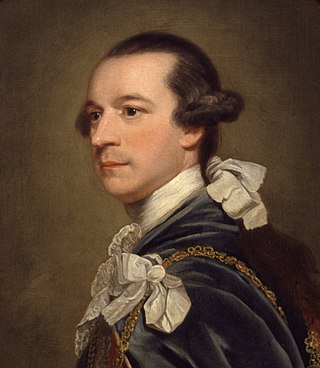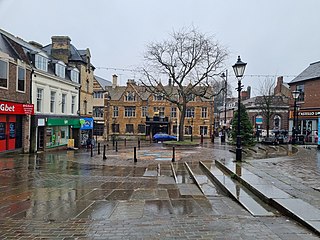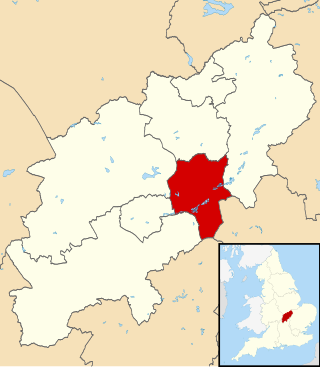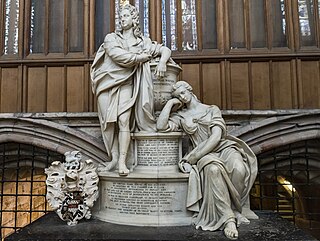
Northamptonshire is a ceremonial county in the East Midlands of England. It is bordered by Leicestershire, Rutland and Lincolnshire to the north, Cambridgeshire to the east, Bedfordshire, Buckinghamshire, Oxfordshire to the south and Warwickshire to the west. Northampton is the largest settlement and the county town.

Charles Watson-Wentworth, 2nd Marquess of Rockingham, was a British Whig statesman and magnate, most notable for his two terms as prime minister of Great Britain. He became the patron of many Whigs, known as the Rockingham Whigs, and served as a leading Whig grandee. He served in only two high offices during his lifetime but was nonetheless very influential during his one and a half years of service.

Wellingborough is a market town and civil parish in the North Northamptonshire unitary authority area of Northamptonshire, England. It is 65 miles (105 km) from London and 11 miles (18 km) from Northampton, and is on the north side of the River Nene.

Marquess of Rockingham, in the County of Northampton, was a title in the Peerage of Great Britain. It was created in 1746 for Thomas Watson-Wentworth, 1st Earl of Malton. The Watson family descended from Lewis Watson, Member of Parliament for Lincoln. He was created a Baronet, of Rockingham Castle in the County of Northampton, in the Baronetage of England in 1621. In 1645 he was further honoured when he was raised to the Peerage of England as Baron Rockingham. The third Baron served as Lord-Lieutenant of Kent. In 1714 he was created Baron Throwley, Viscount Sondes and Earl of Rockingham in the Peerage of Great Britain. His eldest son Edward Watson, Viscount Sondes, predeceased him and he was succeeded by his grandson, the second Earl. The second Earl was Lord-Lieutenant of Kent before his early death in 1745. He was childless and was succeeded by his younger brother, Thomas. He had previously represented Canterbury in Parliament.

East Northamptonshire was a local government district in Northamptonshire, England, from 1974 to 2021. Its council was based in Thrapston and Rushden. Other towns included Oundle, Raunds, Irthlingborough and Higham Ferrers. The town of Rushden was by far the largest settlement in the district. The population of the district at the 2011 Census was 86,765.

Baron Vaux of Harrowden is a title in the Peerage of England. It was created in 1523 for Sir Nicholas Vaux. The barony was created by writ, which means that it can pass through both male and female lines. Vaux was succeeded by his son, the second Baron. He was a poet and member of the courts of Henry VIII and Edward VI. The Vaux family was related to queen consort Catherine Parr by the first baron's two wives; Elizabeth FitzHugh and Anne Green. On the death in 1663 of his great-grandson, the fifth Baron, the title fell into abeyance between the late Baron's surviving sister Joyce, and the heirs of his deceased sisters Mary, Lady Symeon, and Catherine, Baroness Abergavenny.

The Borough of Wellingborough was a non-metropolitan district and borough in Northamptonshire, England, from 1974 to 2021. It was named after Wellingborough, its main town, but also included surrounding rural areas.

Nicholas Vaux, 1st Baron Vaux of Harrowden was a soldier and courtier in England and an early member of the House of Commons. He was the son of Lancastrian loyalists Sir William Vaux of Harrowden and Katherine Penyson, a lady of the household of Queen Margaret of Anjou, wife of the Lancastrian king, Henry VI of England. Katherine was a daughter of Gregorio Panizzone of Courticelle, in Piedmont, Italy which was at that time subject to King René of Anjou, father of Queen Margaret of Anjou, as ruler of Provence. He grew up during the years of Yorkist rule and later served under the founder of the Tudor dynasty, Henry VII.

Finedon is a town and civil parish in North Northamptonshire, England, with a population at the 2021 census of 4,552. In 1086 when the Domesday Book was completed, Finedon was a large royal manor, previously held by Queen Edith, wife of Edward the Confessor.

Charles William Wentworth Fitzwilliam, 5th Earl Fitzwilliam in the peerage of Ireland, and 3rd Earl Fitzwilliam in the peerage of Great Britain, was a British nobleman and politician. He was president three times of the Royal Statistical Society in 1838–1840, 1847–1849, and 1853–1855; and president of the British Association for the Advancement of Science in its inaugural year (1831–2).
Orlingbury is a village and civil parish in the English county of Northamptonshire. It is between the towns of Kettering and Wellingborough. Administratively it forms part of North Northamptonshire but was in the borough of Wellingborough until 2021. At the time of the 2011 census, the parish's population was 439 people.

Little Harrowden is a village and civil parish in North Northamptonshire, England. The village is nearly 3 miles (4.8 km) north-west of Wellingborough, off the A509 road. At the 2011 Census, the population of the parish was 892.

Great Oakley is an outer suburb of Corby, in the civil parish of Corby, in the North Northamptonshire district, in the ceremonial county of Northamptonshire, England. It is situated approximately two miles south west of the town centre and five miles from Kettering. It was represented on Corby Borough Council by one councillor. The population of the Great Oakley Ward of Corby Borough Council at the 2011 Census was 2,248.

North Northamptonshire is one of two local government districts in Northamptonshire, England. Its council is a unitary authority, being a district council which also performs the functions of a county council. It was created in 2021. The council is based in Corby, the district's largest town. Other notable towns are Kettering, Wellingborough, Rushden, Raunds, Desborough, Rothwell, Irthlingborough, Thrapston and Oundle.
Edward Vaux, 4th Baron Vaux of Harrowden was an English peer. He was the son of George Vaux (1564–1594) and his wife Elizabeth Roper, and the grandson and heir of William Vaux, 3rd Baron Vaux of Harrowden. He succeeded his grandfather as Baron Vaux of Harrowden in August 1595, just before his seventh birthday.

Milton Hall near Peterborough, is the largest private house in Cambridgeshire, England. As part of the Soke of Peterborough, it was formerly in Northamptonshire. It dates from 1594, being the historical home of the Fitzwilliam family, and is situated in an extensive park in which some original oak trees from an earlier Tudor deer park survive. The house is a Grade I listed building; the garden is Grade II*.

Hon. Thomas Watson, later known as Thomas Watson-Wentworth, of Wentworth Woodhouse in Yorkshire, was an English landowner and politician who sat in the House of Commons between 1701 and 1723.

The Rockingham Mausoleum, Wentworth, near Rotherham, South Yorkshire, England is a cenotaph commemorating Charles Watson-Wentworth, 2nd Marquess of Rockingham, who was Prime Minister at the time of his death in 1782. The name by which the memorial is now known is in fact a misnomer, since Charles Watson-Wentworth is buried in York Minster. Eighteenth and nineteenth century sources refer to the edifice simply as "the Monument".

Nicholas Knowles, Knollis or Knollys, 3rd Earl of Banbury, was an English nobleman who sat in the House of Lords but was excluded from the Long Parliament, thus precipitating the famous “Banbury Case” which remains partly unresolved to this day.






















